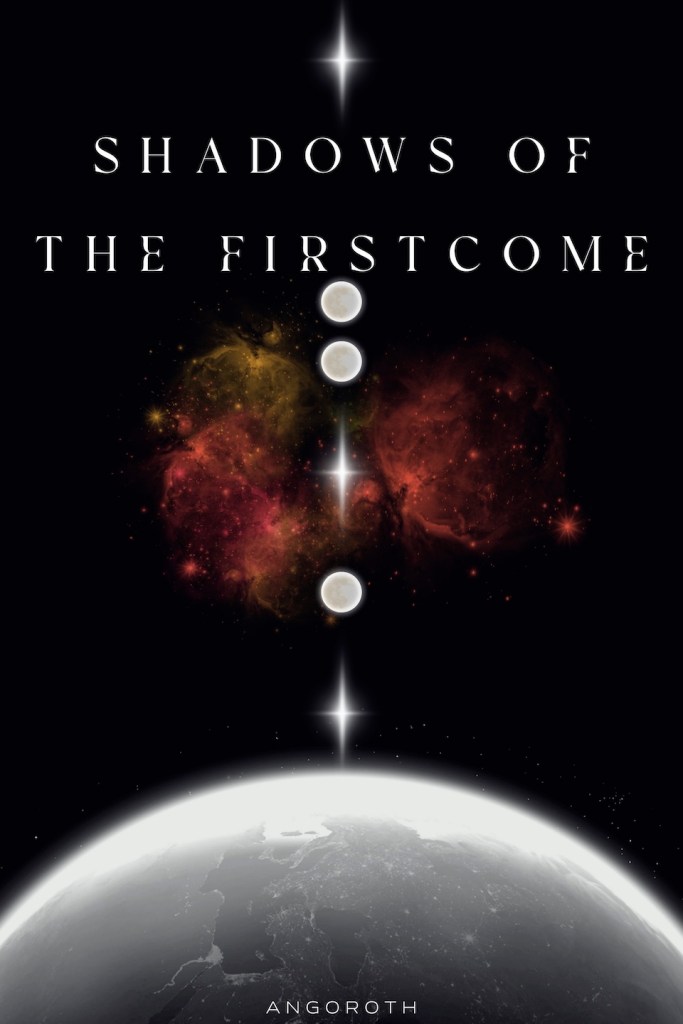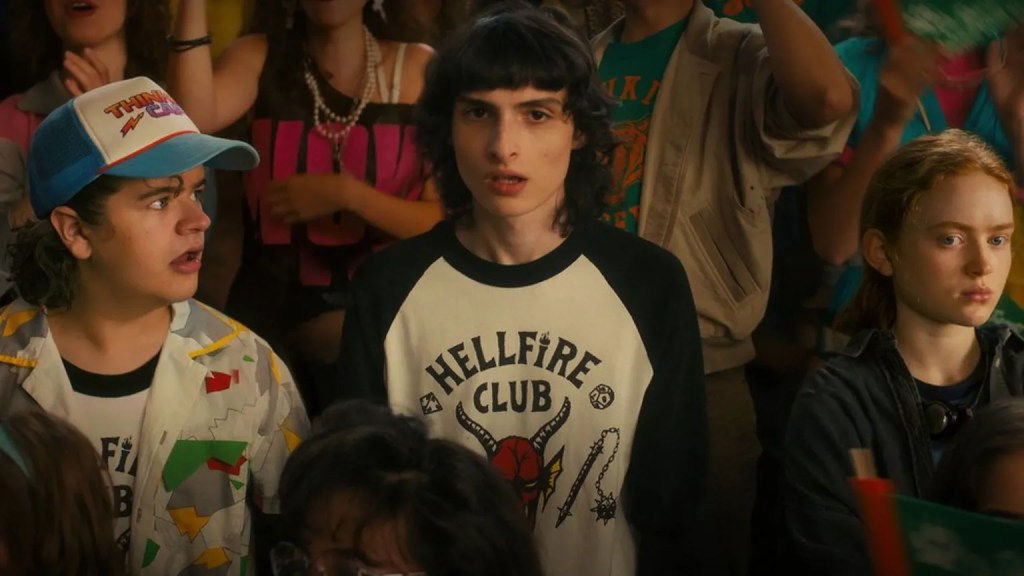
“Was it a mistake to freeze the djinn?” Al Hamra asked, flinching a little as a bullet struck the air hockey table he was hiding behind. The whine of gunfire echoed around the sumptuous lounge, and something valuable cracked loudly in the ricochet from the gunshot. Al Hamra winced and touched a thin, dark-skinned hand to his shaved head, long austere features screwed up with worry as he checked for blood.
“There’s nothing there,” Adam assured him, speaking in loud, strained tones from his cover position between a large potted cactus and the heavy viewscreen that covered most of the outer wall of the lounge. The viewscreen was currently set to display a soothing galactic scene, the view of the Kua system from the space station they were docked in. Soothing spiritual music played gently over large, tastefully hidden speakers, an incongruous soundtrack to the brazen daytime armed robbery they were currently experiencing. Adam had picked the music earlier in the day, also incongruous given his hulking, heavily-muscled form and his history as a gun for hire. Heavy brows knitted now in a dark, scowling face as he peered over at his captain to check for injuries.
Al Hamra gave a sigh of relief, spun into a crouch and raised himself briefly over the line of the air hockey table, his small accelerator pistol held steady in both hands, and squeezed off two shots in the general direction of the doorway. He ducked down again as the two bandits in the hallway returned fire, drawing another explosion of shrapnel from the air hockey table and blowing a hole in the beer dispenser at the far end of the lounge.
“They might not be here for her,” their sensor operator Siladan yelled from further back in the lounge, where he and their medicurg, Dr. Delecta, were hiding behind a heavy marble flower stand. The marble was chipped from the rapid series of shots that had driven them there, and a torn mess of flowers and dark earth scattered the deck in front of the stand. From Adam’s position near the wall he could see Siladan, a ragged pink flower petal caught in his messy beard and his long, wavy dark hair falling around an olive-skinned face sallow with fear. “It could just be an ordinary robbery,” Siladan added, ducking back as another wild shot reverberated through the lounge.
“On Coriolis station?!” Al Hamra demanded, yelling over the brief clatter of glasses falling in a cabinet to the rear of the lounge. Coriolis station was an enormous, well-regulated space station at the center of every trade route in the Third Horizon, and their ship the Phoenix of Hamura was docked in its most reputable shipping zone, Neoptra spaceport on the Ring that surrounded the station’s core areas. Robberies of any kind did not happen here, let alone armed assaults like this.
As Siladan gave a cramped, anxious shrug a voice called out to them from the hallway outside the lounge. The intruders were hiding in a stretch of hallway flanked by two observation lounges, which opened at its far end into the airlocks and docking chamber, and beyond that the elevators they had used to come from the lower decks. “Hand over the girl and nobody has to get hurt!” One of their interlopers yelled out, punctuating his demand with a brief burst of wild, random gunfire that tore a nasty channel through the elegant tiling in the far corner of the room.
So, they were here for the Djinn.
Adam looked to Al Hamra, who shook his head. Absolutely not. The woman these footpads were looking for was their only income, and they could not afford to give her up. Sometimes you have to fake it to make it, and the crew of the Phoenix of Hamura were deep on the play. United as a team by an unexpected shipwreck, they had decided to go all-in on a second-hand, converted luxury yacht, which they intended to use to make money from fringe activities on the fringe of the Third Horizon. Unfortunately right now they were trapped in Coriolis station at the Third Horizon’s center, where every trade route and every Faction intrigue converged, where work should be easy to come by but where so far, in the week since they had taken possession of their armored yacht, they had found none.
Except, that is, for the Data Djinn frozen in their cryogenic chambers. In their quest for quick paying work they had soon found themselves at Wahib’s Cantina, where a woman called Arkial Lima had found them and begged them to freeze her for a week in their stasis hold. An easy job with the dubious payoff of a promising tidbit of information from the Data Djinn’s extensive collection, but at least a small start on their path to riches. When they took her in they knew dangerous people were looking for her, but they had not expected them to find her so quickly, or to approach them so brazenly. They could not give her up, for reasons of cold-blooded commerce if not compassion. She was their only payday and this yacht that these footpads were slowly tearing apart was an expensive investment.
“Icons damn you!” Al Hamra yelled back, his voice a little reedy with the tension of the moment. “Over our dead bodies!” This was greeted with a torrent of curses, and promises to make it so.
Adam gestured to Al Hamra for the gun, but the captain shook his head. The parquet floor of the lounge was polished but treated to be non-slip, like every piece of decking on a good ship, and he did not trust he could slide the gun over, let alone toss it safely. Adam was the team’s soldier, their best shot and their most experienced fighter, but currently they only had two guns for the whole team, and they had not been carrying them in the lounge when the incursion began.
“Where is Olivia?” Adam yelled, staying crouched low as another short burst of fire exploded along the wall behind him. Al Hamra returned fire, two careful shots to each corner of the entry. Their attackers were under cover on each side of the doorway to the elevator hall, and although there was another elevator hall at the other end of the lounge area, it was a hundred meters away and would mean surrendering control of the entire living space to their attackers. Olivia Greenstar, their engineer, was the owner of their only other firearm, a Vulcan carbine that they all assumed she had stored in her room, and yielding the living space in a retreat to the rear elevator would mean giving up control of her room. Unfortunately she was not on this deck, and they could not access her room without her.
“I found her!” Dr. Delecta called back after a second’s quiet. Dr. Delecta was crouched deep in cover behind the marble flowerpot, out of Al Hamra’s and Adam’s view. She was also the only one of them carrying a comms unit when the attack started. “Olivia!” She said in a quieter voice. “Where are you? Can you get up here by the rear elevator?”
There was a pause, a brief inhalation of breath as Dr. Delecta reacted in shock to whatever Olivia told her. “Is it bad?” As she listened, Adam made frantic gestures to Siladan, who he could still see, trying to encourage him to tell the medicurg to hurry it up. Siladan shrugged, and Dr. Delecta’s voice was lost under the roar of another burst of gunfire. Glass tinkled as a rare and valuable Miran glow-lamp shattered on the bench just beyond the flower stand.
“She’s injured!” Dr. Delecta called out to them. “She was in the workshop when they came in, and they shot her before she could seal it.”
Al Hamra cursed. “We need her gun!” He snarled. “Can she get up here?”
“Tell her not to come up the front service elevators!” Adam called to Dr. Delecta. “Or they’ll –“
As he said this there was a sudden snarl of gunfire, screams of pain from the men at the lounge entrance. The gunfire continued, an enormous wave of roaring sound as someone unloaded an entire cartridge of vulcan ammunition in the hallway. More screams, a brief spasm of someone else’s gun firing, and then silence.
“Salaam, motherfuckers!” A woman’s voice interrupted the silence from the hallway, accompanied by another woman’s nervous giggle.
Al Hamra rose slowly from behind the air hockey table, pistol at the ready, and then gestured to Adam, who stepped out of the cover of the cactus. Behind them Siladan and Dr. Delecta emerged from the flower stand, Siladan brushing dirt and broken stalks off of his dhoti as he stepped around the marble structure and Dr. Delecta towering behind him, her tall dark form resplendent in a shimmering green lounging gown. They all stared at the entrance, where a pale-skinned, golden-haired woman in work coveralls leaned on a tiny, skinny woman dressed in the same simple grey deck clothes. The golden-haired woman was limping, favoring her right leg, and a trail of blood smeared the floor behind her left foot. A smoking, snub-nosed semi-automatic rifle rested by its butt on her right hip, and she grinned at the group as she stood in the doorway, the tiny woman beside her struggling to hold her weight.
“I guess she kept the gun in her workshop,” Al Hamra concluded, as Dr. Delecta rushed past him towards their engineer. A moment later the small woman she was leaning on gave up and let Olivia slide to the floor, grunting and grimacing with the pain from her leg.
“How did you know which elevator to use?!” Adam demanded, speaking to the smaller woman. This was Saqr, their pilot, so short she barely reached to Adam’s sternum as she stood in front of him.
“I was on the bridge,” she told the big man, looking up at him from beneath a crop of short, messy dark hair. “I used the security cameras. When we saw they were in the hallway Olivia came up the elevator and I just helped her to walk through.” The elevators were behind the bridge, giving them the chance to flank the intruders. She turned to look behind her into the hallway, her face screwing up in disgust at the mess Olivia had made. The two men lay dead, blood and gore smeared over the walls and the fine parquet flooring and chunks of shrapnel, wood, glass and clothing spread over a wide area. “You really did a number on them, Olivia,” she observed, straining to sound neutral as she gulped down what might have been bile. “Should we wake Arkial and tell her about this?”
Al Hamra stood in silence for a moment beside the diminutive pilot, watching as as Dr. Delecta inspected Olivia’s foot injury, and shook his head when he came to a decision. “No! We leave her in her chamber. If the Data Djinn wakes up she may panic and leave,” Al Hamra explained. “Which means she’ll take her info with her. Right now we have no witnesses to this, we can take their gear and hide them in stasis chambers until we leave the station. We can tell Arkial about it when she wakes up. On schedule,” he hissed for emphasis, “And confident we handled our part of our deal.” He gestured in the vague direction of the stasis hold, over a hundred meters behind them on the same level. “We have sixty four stasis chambers, plenty of room to spare until we get a chance to space the bodies.”
“You’re seriously thinking of hiding the bodies?” Olivia asked him through clenched teeth as Delecta fussed at the wound, voice rising in incredulity. “You want to just keep them frozen in here while we look for work?”
“You got a better idea?” Al Hamra demanded as he stood up from the bodies. “These guys were here to kill our client, which I would wager means they aren’t from up there.” With this he pointed above their head, to the higher levels of the station where the authorities resided. “They didn’t know she was in the stasis hold or they’d have come up the back elevators, which means they don’t know her personally, someone hired them. They’ve gotta be from below,” and with that he pointed down. “So either we’ve killed everyone who was out to get her and we’re in the clear, or more of them will come. But nobody’s alerting the Judicators, are they?” He pointed to an accelerator pistol lying beside the nearest body. “No guns on deck, right? So they carried that in here against all Station Law just to get to our Djinn. The Judicators aren’t coming for us, Olivia, and if we try to do the right thing we’re just gonna make our lives miserable. So we freeze them and go about our business as if it never happened.”
He looked around at his crew, who had gathered around him as he spoke. “You wanted adventure,” Al Hamra pointed out to them, running one hand over the dark skin of his freshly-shaved head. “Well, you got your wish. Let’s freeze these scroungers, set some alarms on the gangways, and get back to our drinks.”
If you’re interested in finding out what will happen to the crew of the Phoenix of Hamura and why they have a Djinn forzen in their hold, read the rest of the story at Royal Road.









